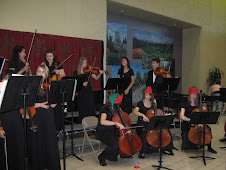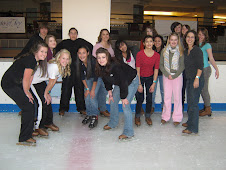ave the Date***
The calendar is up-to-date on our website: www.titanorchestras.com
Tue Feb 22 - District Budget Committee meeting@McKay, wear blue, 6pm
Sat Feb 26 - All City at North, 7pm
Wed March 2 - Chamber @ Capital Manor, 7pm
Thu March 3 - YMMP Meet 'n Greet, 6:15pm
Sat March 5 - Solo and Ensemble daytime
Wed March 9 - Chamber at Walker, evening
Mon March 14 - SPRING CONCERT, 7pm
Contained within:
1) Chicago updates
2) Sectional schedule reviewed
3) Planning for next year
4) February 22 District Budget Committee meeting - PARENTS, please attend
1) Chicago updates
Chicago students and chaperons should have their jacket order in today - please email Ms. S with the information if you did not get your paperwork in. Payment is due by the time the jackets are here.
Chicago rehearsal schedule is below:
Wednesday Feb 23 2:30 – 3:30 (no Sinfonietta Viola Sectional)
Monday Feb 28 3:30 – 5pm (after Sinfonietta Violin Sectional)
Either Friday March 4 - 2:40 - 4:30 or Friday March 11 - 2:40 – 5
One of these Fridays will be cancelled due to Ms. S's schedule... but, put both on your calendar for right now.
Sinfonietta Cellos *will* have their sectional on the Friday we don’t have Chicago rehearsal
Monday Mar 14 - Spring Concert (combined group performs March Slav, Sinfonietta performs Capriol and Texians)
Tuesday Mar 15 - 4 - 5pm - final dress rehearsal (this rehearsal might be extended if we need more time)
2) Sectional schedule reviewed
Here is the reminder about sectionals - this schedule is set through the March 14 concert:
Mondays - All Violins (including Chamber 2/28 and 3/7)
Wednesdays - All Violas (including Chamber 2/23 and 3/2)
Wednesdays - Titan Basses
Thursdays - Titan Celli
Fridays - Sinfonietta Cellos
3) Planning for next year
For 9th - 11th graders, all you need to do for your schedule planning next year is to put down "Orchestra" on your sheet - we will do auditions and placements in March and April. When I turn in the sheets for placement, the counselors will put you into the correct class.
At this point in planning, Chamber Orchestra (the advanced orchestra) next year will be double blocked and all Chamber students will be required to enroll in Advanced Symphony. But, the double block will NOT occur during the daytime - students will have one class time period and a second period of credit that will include after school rehearsals and sectionals. More details about that schedule will happen later in the spring once the new Chamber group has been auditioned.
4) February 22 School Board Budget Committee meeting - PARENTS, please attend
ALL PARENTS ARE ASKED TO ATTEND THE SCHOOL BOARD's Budget Committee MEETING at North High School at 6pm on February 22nd. At this meeting Superintendant Sandy Husk will outline her budget for the 2011-2012 year. Parents in support of music in the Salem-Keizer school district are asked to WEAR THE COLOR BLUE to the meeting to show our support for music. This request comes to you from the advocacy group Friends of Music. Thanks for your support.
Thanks for reading all the way down to the end of the newsletter...
~Ms S.
Thursday, February 17, 2011
Wednesday, February 9, 2011
Some interesting articles/links from OR Arts Teacher Listserve
22. Study Helps Explain Why Music Is So Widely Popular Across Cultures
A study by Robert Zatorre and Valorie Salimpoor of McGill University in Montreal shows that the release of dopamine is involved both in anticipating a particularly thrilling musical moment and in feeling the rush from it. In addition, researchers found that even the anticipation of listening to intensely pleasurable music was enough to trigger the release of dopamine. Dopamine is commonly associated with the reward system of the brain, providing feelings of enjoyment and reinforcement to motivate a person proactively to perform certain activities; it is also connected with the development of sociability. Volunteers in the study chose a wide range of music – from classical and jazz to punk, tango and even bagpipes –implying that the neural response to music is not associated with any particular type of music.
Articles about the research may be found at WebMD (http://www.webmd.com/brain/news/20110109/music-gives-brain-natural-buzz) and MSNBC (http://www.msnbc.msn.com/id/40990339/ns/health-behavior/); the full text of the Nature Neuroscience article, with an abstract, is available at http://www.nature.com/neuro/journal/vaop/ncurrent/full/nn.2726.html.
23. The Skills Connection between the Arts and 21st Century Learning
In an EdWeek commentary, Bruce Taylor (director of education for the Washington National Opera, in Washington, D.C.) argues that “the necessary skills to function in an increasingly complex, conceptual, and globalized 21st-century society and economy,” as well as the “so-called ‘habits of mind’ that will enable [students] to develop the skills of creativity, critical thinking, and problem-solving,” are “in reality, arts skills.” In addition, the arts relate to the unique ways in which human beings think, postulated in Scientific American by Marc Hauser at Harvard University as four “key characteristics of the human mind” that distinguish us from our nearest primate relative, the chimp. To focus on those characteristics – generative computation, promiscuous combination of ideas, mental symbols, and abstract thought – “is to enhance the very qualities that make us ... us. In other words, to be artistic is to be human.”
To read the EdWeek commentary by Bruce Taylor, go to http://www.edweek.org/ew/articles/2011/02/02/19taylor_ep.h30.html?tkn=RVXFqYjnTgKEXardREpTCBxCEBx7Ci%2Bz6sNH&cmp=clp-edweek; to read the Scientific American article by Marc Hauser, go to http://www.wjh.harvard.edu/~mnkylab/publications/recent/mindSciAm.pdf
24. The Arts as Radical Ideas to Really Save Education
As part of an article in Fast Company Magazine (How to Spend $100 Million to Really Save Education), thirteen education experts were asked for a radical idea that they would spend $100 million on, to save education. Diane Ravitch’s response (Radical Idea #3) was, “I’d focus on the arts – music and visual arts and dance, all the things that make kids joyful. Kids need a reason to come to school, and testing is not a good reason.” To read the article, go to http://www.fastcompany.com/magazine/152/how-to-spend-100-million-to-really-save-education.html.
25. Math Concepts and Art
Recent college graduate Vi Hart is making a name for herself as a recreational mathemusician, who is hoping to help students see math as an art. She seems to be attracting more teenage girls to the subject. Hart began posting on YouTube videos of herself doodling math concepts, which have since gone viral. “I want people to feel they can do this. People can. It’s mathematics that anyone can do,” she said.
To read an article about Vi Hart, go to http://www.nytimes.com/2011/01/18/science/18prof.html?_r=4&ref=science; to see some of Ms. Harts videos, go to http://www.youtube.com/user/Vihart#p/u/7/e4MSN6IImpI (doodling in math class), http://www.youtube.com/user/Vihart#p/u/6/CfJzrmS9UfY (drawing stars), http://www.youtube.com/user/Vihart#p/u/6/heKK95DAKms (drawing snakes), http://www.youtube.com/user/Vihart#p/u/2/Yhlv5Aeuo_k (prime numbers), http://www.youtube.com/watch?v=qsE2UKkIKXU&feature=fvsr (hyperbolic planes and computational balloon twisting), and http://www.youtube.com/watch?v=DK5Z709J2eo (sums of infinite series).
A study by Robert Zatorre and Valorie Salimpoor of McGill University in Montreal shows that the release of dopamine is involved both in anticipating a particularly thrilling musical moment and in feeling the rush from it. In addition, researchers found that even the anticipation of listening to intensely pleasurable music was enough to trigger the release of dopamine. Dopamine is commonly associated with the reward system of the brain, providing feelings of enjoyment and reinforcement to motivate a person proactively to perform certain activities; it is also connected with the development of sociability. Volunteers in the study chose a wide range of music – from classical and jazz to punk, tango and even bagpipes –implying that the neural response to music is not associated with any particular type of music.
Articles about the research may be found at WebMD (http://www.webmd.com/brain/news/20110109/music-gives-brain-natural-buzz) and MSNBC (http://www.msnbc.msn.com/id/40990339/ns/health-behavior/); the full text of the Nature Neuroscience article, with an abstract, is available at http://www.nature.com/neuro/journal/vaop/ncurrent/full/nn.2726.html.
23. The Skills Connection between the Arts and 21st Century Learning
In an EdWeek commentary, Bruce Taylor (director of education for the Washington National Opera, in Washington, D.C.) argues that “the necessary skills to function in an increasingly complex, conceptual, and globalized 21st-century society and economy,” as well as the “so-called ‘habits of mind’ that will enable [students] to develop the skills of creativity, critical thinking, and problem-solving,” are “in reality, arts skills.” In addition, the arts relate to the unique ways in which human beings think, postulated in Scientific American by Marc Hauser at Harvard University as four “key characteristics of the human mind” that distinguish us from our nearest primate relative, the chimp. To focus on those characteristics – generative computation, promiscuous combination of ideas, mental symbols, and abstract thought – “is to enhance the very qualities that make us ... us. In other words, to be artistic is to be human.”
To read the EdWeek commentary by Bruce Taylor, go to http://www.edweek.org/ew/articles/2011/02/02/19taylor_ep.h30.html?tkn=RVXFqYjnTgKEXardREpTCBxCEBx7Ci%2Bz6sNH&cmp=clp-edweek; to read the Scientific American article by Marc Hauser, go to http://www.wjh.harvard.edu/~mnkylab/publications/recent/mindSciAm.pdf
24. The Arts as Radical Ideas to Really Save Education
As part of an article in Fast Company Magazine (How to Spend $100 Million to Really Save Education), thirteen education experts were asked for a radical idea that they would spend $100 million on, to save education. Diane Ravitch’s response (Radical Idea #3) was, “I’d focus on the arts – music and visual arts and dance, all the things that make kids joyful. Kids need a reason to come to school, and testing is not a good reason.” To read the article, go to http://www.fastcompany.com/magazine/152/how-to-spend-100-million-to-really-save-education.html.
25. Math Concepts and Art
Recent college graduate Vi Hart is making a name for herself as a recreational mathemusician, who is hoping to help students see math as an art. She seems to be attracting more teenage girls to the subject. Hart began posting on YouTube videos of herself doodling math concepts, which have since gone viral. “I want people to feel they can do this. People can. It’s mathematics that anyone can do,” she said.
To read an article about Vi Hart, go to http://www.nytimes.com/2011/01/18/science/18prof.html?_r=4&ref=science; to see some of Ms. Harts videos, go to http://www.youtube.com/user/Vihart#p/u/7/e4MSN6IImpI (doodling in math class), http://www.youtube.com/user/Vihart#p/u/6/CfJzrmS9UfY (drawing stars), http://www.youtube.com/user/Vihart#p/u/6/heKK95DAKms (drawing snakes), http://www.youtube.com/user/Vihart#p/u/2/Yhlv5Aeuo_k (prime numbers), http://www.youtube.com/watch?v=qsE2UKkIKXU&feature=fvsr (hyperbolic planes and computational balloon twisting), and http://www.youtube.com/watch?v=DK5Z709J2eo (sums of infinite series).
Subscribe to:
Comments (Atom)



























